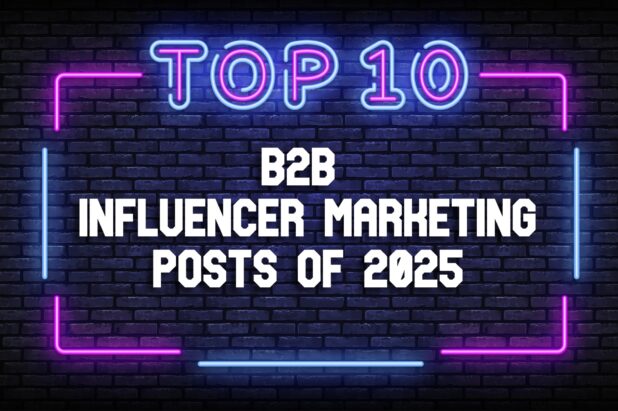I’m not sure of the source, but there’s a common saying in our industry that no one dreams of becoming a B2B marketer when they’re a kid. Many of us have taken pretty indirect routes to get here and along the way there was a lot of trial and error, hypothesis and testing and no end to learning something new.
One of those learning opportunities is the ever evolving language of B2B marketing. Every year it seems new acronyms get added to the mix. I can remember when “SEO” and “CRO” were new let alone OKRs, PLG, or ABX, At least there are some fun acronyms like TOFU, MOFU and BOFU 🙂
I think of myself as a lifelong learner and eternal student when it comes to B2B marketing. So, to keep track of all of these acronyms as I’ve come across them, I’ve kept a swipe file in Evernote and then Google Docs. Realizing the list is quite long, I did a little more research to round things out to a nice number – 75.
Whether you’re listening to a B2B marketing podcast, reading a post from your favorite B2B marketing influencer or reading a post or article and come to wonder what a particular acronym means, hopefully this list will be helpful when Google, ChatGPT or Perplexity try to give you the best answer.
B2B Marketing Strategy & Planning
These acronyms are for high-level frameworks, market definitions, and strategic approaches that make up the foundation of a B2B marketing plan before execution begins.
- ABM (Account-Based Marketing): This is a focused growth strategy where marketing and sales collaborate to create personalized buying experiences for a select set of high-value target accounts, such as launching a dedicated webinar series for just the top 10 companies in the Fortune 500.
- ABS (Account-Based Selling): The corresponding sales methodology to ABM, where sales representatives use personalized outreach and in-depth account insights to engage specific stakeholders within a target company.
- ABX (Account-Based Experience): The evolution of ABM that focuses on creating a relevant, trusted, and consistent experience for all individuals within the target account across every single touchpoint, from the first ad they see to post-sale support.
- AIDA (Awareness, Interest, Desire, Action): This is a classic marketing model that describes the four stages a consumer goes through in the buying process, which marketers use to structure their campaigns and content funnels.
- ICP (Ideal Customer Profile): A detailed, fictitious description of the type of company that would get the most value from your product, which helps a marketing team focus their resources on the most promising market segments.
- NPL (New Product Launch): The coordinated effort and strategic plan for bringing a new product or a major new feature to the market, involving everything from initial market research to the final launch day announcement.
- OKR (Objectives and Key Results): A goal-setting framework where the team sets ambitious objectives (the “what”) and then defines specific, measurable key results (the “how”) to track progress, such as aiming to “Increase Market Share” with a KR of “Launch in two new regions this quarter.”
- PLG (Product-Led Growth): This is a go-to-market strategy that relies on the product itself as the primary driver of customer acquisition, conversion, and expansion, exemplified by companies that offer a freemium or free trial model.
- TAL (Target Account List): The specific, predefined list of companies that an organization will focus its ABM and sales efforts on, which is often tiered by priority.
- TAM (Total Addressable Market): Represents the total revenue opportunity that is available for a product or service if 100% market share were achieved, which is often used to demonstrate the potential of a business to investors.
- USP (Unique Selling Proposition): The core benefit or feature that makes your business better than the competition, which should be a clear and compelling message in all marketing materials.
Lead & Pipeline Management
Here are terms that reference the buyer’s journey and the specific classification of leads as they are identified, nurtured, and passed between marketing and sales.
- BANT (Budget, Authority, Need, Timeline): A traditional lead qualification framework used by sales reps to determine if a prospect is a good fit by asking questions to confirm they have the necessary budget, authority to make a decision, a real need for the solution, and a defined timeline for implementation.
- BOFU (Bottom of Funnel): The final stage of the buying process, where content and offers are designed for prospects who are ready to make a purchase decision, such as a free trial or a request-a-demo offer.
- MAL (Marketing Accepted Lead): A very early-stage lead that has met the absolute minimum criteria to be accepted by the marketing team for further nurturing, such as someone who simply subscribed to a newsletter.
- MOFU (Middle of Funnel): The consideration stage of the buyer’s journey where prospects are actively researching and comparing different solutions to their problem, making them receptive to content like case studies and product webinars.
- MQL (Marketing Qualified Lead): A lead that marketing has deemed more likely to become a customer based on their engagement and behaviors, such as someone who has downloaded multiple whitepapers and visited the pricing page.
- SAL (Sales Accepted Lead): An MQL that has been reviewed and officially accepted by the sales team, confirming it meets their criteria and is worth their time to pursue.
- SQL (Sales Qualified Lead): This is a lead that has been fully vetted through an initial conversation with a sales rep and is now considered a legitimate potential opportunity that will be actively worked by the sales team.
- TOFU (Top of Funnel): The initial awareness stage of the buyer’s journey, where marketing efforts focus on attracting a broad audience and educating them about a problem, often through blog posts or social media content.
Search, Social, Influencer & Content Marketing
Amongst this group we have the primary channels and tactics TopRank Marketing uses for creating and distributing best answer content experiences to attract and engage B2B audiences.
- AIO (Artificial Intelligence Overviews): Previously known as SGE (Search Generative Experience), this refers to the AI-generated conversational answers and summaries that appear at the top of Google search results, which requires a new approach to SEO.
- CTA (Call to Action): A specific instruction in your marketing content designed to get the audience to take an immediate next step, such as a “Download the Free Guide” button at the bottom of a blog post.
- E-E-A-T (Experience, Expertise, Authoritativeness, Trustworthiness): The framework of quality signals that Google’s Quality Rater Guidelines reference for use in evaluating how reliable a piece of content is, making it crucial for B2B marketers to feature content from genuine experts.
- EGC (Employee-Generated Content): Any content voluntarily created and shared by a company’s own employees, which can be a powerful tool for authentic brand advocacy on platforms like LinkedIn.
- KOL (Key Opinion Leader): A highly respected and influential individual or organization within a specific industry, whom B2B brands often partner with for influencer marketing campaigns to build credibility.
- RSS (Really Simple Syndication): The technology that powers content feeds, most commonly used today to distribute new podcast episodes to subscribers across different listening apps.
- SEM (Search Engine Marketing): A form of internet marketing that involves promoting websites by increasing their visibility in search engine results pages primarily through paid advertising (PPC).
- SEO (Search Engine Optimization): The practice of improving your website to increase its visibility in organic (non-paid) search engine results for relevant keywords.
- SERP (Search Engine Results Page): The page of results that a search engine like Google shows to a user after they type in a query.
- SME (Subject Matter Expert): A person who has deep knowledge, authority and influence in a particular topic, and B2B marketers frequently collaborate with them to create highly credible content like technical whitepapers or webinars
- SMM (Social Media Marketing): The use of social media platforms like LinkedIn, X (formerly Twitter), or Facebook to build your brand, attract followers, and drive website traffic.
- SMO (Social Media Optimization): This is the process of strategically fine-tuning your social media profiles and content to maximize your reach and engagement with your target audience.
- UGC (User-Generated Content): Any content-such as reviews, testimonials, or social media posts-created by your customers rather than your brand, which often serves as powerful social proof.
- WOM (Word-of-Mouth): Organic customer recommendations and discussions about your brand, which is often the most trusted and effective form of marketing.
Digital Advertising & Technology (AdTech)
The following acronyms are specific to paid media including pricing models and the technology used to deliver ads.
- AdTech (Advertising Technology): The general term for the variety of software and tools that advertisers use to target, deliver, and analyze their digital advertising campaigns.
- CPC (Cost Per Click): The actual price an advertiser pays each time a prospect clicks on their ad in a platform like Google Ads or LinkedIn; for example, a company might aim for a CPC of under $5.00 for a specific keyword.
- CPM (Cost Per Mille / Cost Per Thousand): A common pricing model where advertisers pay a set price for every one thousand impressions their ad receives, which is often used for brand awareness campaigns where clicks are not the primary goal.
- DMP (Data Management Platform): A technology platform used to collect and manage large amounts of primarily anonymous, third-party audience data for the purpose of more precise ad targeting.
- DSP (Demand-Side Platform): Software that allows advertisers and agencies to buy ad inventory from multiple sources in an automated and centralized way.
- RTB (Real-Time Bidding): The automated process where ad impressions are bought and sold in a lightning-fast auction that happens in the milliseconds it takes for a user to load a webpage.
Marketing Technology (MarTech) & Data
These acronyms are foundational platforms, software, and data management solutions that enable modern B2B marketing operations.
- ABM Platform: A specialized software solution, like 6sense or Demandbase, that is specifically designed to help companies identify target accounts, deliver personalized advertising, and measure the results of their account-based marketing efforts.
- CDP (Customer Data Platform): A sophisticated system that collects customer data from all sources, cleans it, and merges it to create a single, unified profile for each customer that can be used to personalize marketing.
- CMS (Content Management System): The software a company uses to create, edit, and publish content on its website without needing to write code from scratch, with WordPress being a very common example.
- CRM (Customer Relationship Management): A technology platform that acts as a central database for all customer and prospect interactions, allowing a sales rep to see every email, phone call, and marketing engagement before a meeting.
- DAM (Digital Asset Management): A centralized system that helps a company store, organize, and distribute all of its digital content, such as logos, product photos, and videos, ensuring brand consistency.
- GenAI (Generative AI): A type of artificial intelligence that can create entirely new content, such as writing a first draft of a blog post, designing an image, or generating ad copy variations like ChatGPT, Gemini or Claude.
- GTM (Google Tag Manager): A free tool from Google that allows marketers to add and update their own tracking codes and marketing tags on a website without having to involve a web developer for every change.
- LLM (Large Language Model): The foundational AI technology behind tools like ChatGPT, which is trained on massive amounts of text data to understand and generate human-like language.
- MAP (Marketing Automation Platform): A software platform like Marketo or HubSpot that allows marketers to automate repetitive tasks like sending nurture emails, posting to social media, and scoring leads based on their behavior.
- MarTech (Marketing Technology): The general term for the entire stack of software and tools that a marketing department uses to execute and measure its activities.
- PII (Personally Identifiable Information): This refers to any data that could be used to identify a specific person, such as their name or email address, and which must be handled securely to comply with privacy regulations like GDPR.
Analytics, Measurement & Optimization
Here we have a cornucopia of what to do with the data – acronyms for the metrics, methodologies, and financial calculations used to measure performance, prove value, and optimize every aspect of the B2B marketing mix.
- A/B Testing: The practice of comparing two different versions of a single asset, like a webpage headline or an email subject line, to see which one performs better with your audience.
- ARPA (Average Revenue Per Account): A metric calculated by dividing the total revenue by the number of customer accounts, which is especially useful for B2B companies that serve multiple users within a single client company.
- ARPU (Average Revenue Per User): This metric represents the average revenue generated from an individual user, typically calculated on a monthly or yearly basis.
- ARR (Annual Recurring Revenue): A key metric for subscription-based businesses that shows the total amount of predictable revenue a company can expect to receive from its customers in a year.
- BR (Bounce Rate): A web analytic that measures the percentage of visitors who land on a webpage and then leave without clicking on anything or visiting any other pages on the site.
- CAC (Customer Acquisition Cost): A business metric that calculates the total sales and marketing cost required to acquire a single new customer over a specific period.
- CPA (Cost Per Acquisition): Measures the cost to generate a single conversion for a specific campaign, which could be anything from a sale to a lead form submission.
- CPL (Cost Per Lead): Shows how cost-effective your marketing campaigns are at generating new leads for your sales team.
- CR / CVR (Conversion Rate): The percentage of users or visitors who complete a desired action, such as filling out a contact form, which is a key indicator of your website’s or campaign’s effectiveness.
- CRO (Conversion Rate Optimization): The systematic process of testing and improving your website and landing pages with the specific goal of increasing the percentage of visitors who convert.
- CTR (Click-Through Rate): A metric that measures the percentage of people who saw an ad, link, or email and then actually clicked on it, indicating how compelling your message was.
- Engagement Rate: A social media metric that measures the level of interaction a piece of content receives from users (likes, shares, comments) relative to the size of its audience.
- GA (Google Analytics): The famously free web analytics service from Google that provides detailed statistics about a website’s traffic, user behavior, and conversion performance.
- KPI (Key Performance Indicator): A measurable value that demonstrates how effectively a company is achieving its key business objectives, such as “increase MQLs by 15% this quarter.”
- LTV / CLV (Customer Lifetime Value): This is a predictive metric that estimates the total net profit a company can expect to make from a single customer over the entire duration of their relationship.
- NPS (Net Promoter Score): A famous metric that measures customer loyalty by asking customers a single question: “How likely are you to recommend our company to a friend or colleague?”
- ROAS (Return On Ad Spend): Used to measure the profitability of an advertising campaign by calculating the amount of revenue generated for every dollar spent.
- SOV (Share of Voice): Tracks your brand’s visibility in the marketplace compared to your competitors, often measured by tracking brand mentions across social media and the web.
- TCV (Total Contract Value): Financial metric that represents the full value of a customer’s contract, including both one-time and recurring charges, giving a snapshot of expected revenue.
- YOY (Year-over-Year): Method of comparing financial or performance data from a specific period (like a quarter) against the same period from the previous year to measure growth.
- YTD (Year-to-Date): The period from the beginning of the current year up to the present day, which is often used for tracking progress toward annual goals.
Sales Roles & Agreements
Last up are acronyms for a few B2B industry sales roles and the formal agreements that govern projects and partnerships.
- BDR (Business Development Representative): A sales role that is primarily focused on generating new business opportunities by conducting outbound prospecting through cold calls, emails, and social media outreach.
- SDR (Sales Development Representative): An inside sales role that focuses on qualifying inbound leads that have been generated by the marketing team to determine if they are ready for a conversation with a senior salesperson.
- SLA (Service Level Agreement): Formal agreement, often between the sales and marketing teams, that defines specific responsibilities and quantifiable expectations, such as the commitment that sales will follow up on all MQLs within 24 hours.
- SOW (Statement of Work): This is a formal document that outlines the specific scope, deliverables, timelines, and costs of a project, which is commonly used when working with agencies or freelance contractors.
Now there’s no claim being made here that this is either a comprehensive list of B2B marketing acronyms or a representation of what every B2B marketer needs to know in order to operate and succeed in the field. But if you’re like me and come across a new term, search Google or a GenAI tool and only get out-dated, unvetted information – it might be useful.



